
Morchella, the true morels, is a genus of edible sac fungi closely related to anatomically simpler cup fungi in the order Pezizales. These distinctive fungi have a honeycomb appearance due to the network of ridges with pits composing their caps. Morels are prized by gourmet cooks, particularly in Catalan and French cuisine, but can be toxic if consumed raw. Due to difficulties in cultivation, commercial harvesting of wild morels has become a multimillion-dollar industry in the temperate Northern Hemisphere, in particular North America, Turkey, China, the Himalayas, India, and Pakistan where these highly prized fungi are found in abundance.

Gyromitra is a genus of about 18 species of ascomycete fungi. They are a false morel - a frequently toxic mushroom that can be mistaken for edible mushrooms of the genus Morchella (morels).
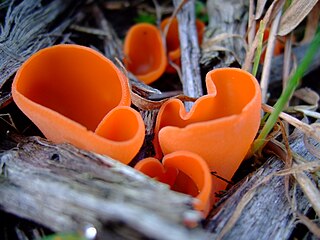
The Pezizales are an order of the subphylum Pezizomycotina within the phylum Ascomycota. The order contains 16 families, 199 genera, and 1683 species. It contains a number of species of economic importance, such as morels, the black and white truffles, and the desert truffles. The Pezizales can be saprobic, mycorrhizal, or parasitic on plants. Species grow on soil, wood, leaves and dung. Soil-inhabiting species often fruit in habitats with a high pH and low content of organic matter, including disturbed ground. Most species occur in temperate regions or at high elevation. Several members of the Sarcoscyphaceae and Sarcosomataceae are common in tropical regions.
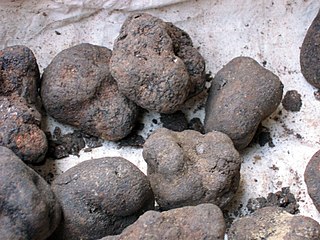
The Tuberaceae are a family of mycorrhizal fungi, in the order Pezizales, that evolved during or after the first major radiation of Angiosperms in the Jurassic period. It includes the genus Tuber, which includes the so-called "true" truffles. It was characterized by the Belgian botanist Barthélemy Charles Joseph du Mortier in 1822. A molecular study of ribosomal DNA by mycologist Kerry O'Donnell in 1997 found that a small clade now redefined as Helvellaceae is most closely related to the Tuberaceae. The mycologist Mary Cloyd Burnley Stifler studied and described fungal family, donating specimens to herbariums across the United States.
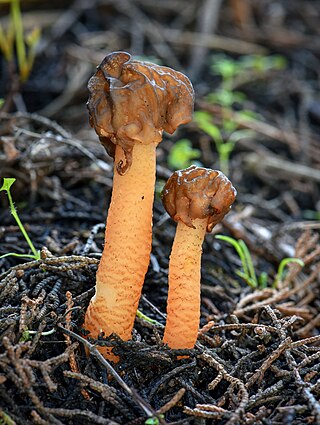
Verpa is a genus of ascomycete fungi related to the morels. Resembling the latter genus in edibility and form, the common name early morels is popular. There are five species in the widespread genus.

The Discinaceae are a family of ascomycete fungi, the best known members of which are the false morels of the genus Gyromitra. Originally erected by Erich Heinz Benedix in 1961, it was found to be a discrete clade in a molecular study of ribosomal DNA by mycologist Kerry O'Donnell in 1997. As of 2008, the family is thought to contain 5 genera and 58 species. As of 2022, the GBIF accepts Discina(Fr.) Fr., Gymnohydnotrya B.C.Zhang & Minter, 1989, GyromitraFr., 1849, HydnotryaBerk. & Broome and Maublancomyces. But calls NeogyromitraS.Imai and PseudorhizinaJacz. doubtful.

The Helvellaceae are a family of ascomycete fungi, the best-known members of which are the elfin saddles of the genus Helvella. Originally erected by Elias Magnus Fries in 1823 as Elvellacei, it contained many genera. Several of these, such as Gyromitra and Discina, have been found to be more distantly related in a molecular study of ribosomal DNA by mycologist Kerry O'Donnell in 1997, leaving a much smaller core clade now redefined as Helvellaceae. Instead, this narrowly defined group is most closely related to the true truffles of the Tuberaceae. Although the Dictionary of the Fungi considered the Helvellaceae to contain six genera and 63 species, genetic analysis has shown that Leucangium, previously classified in this family, is more closely related to the Morchellaceae.
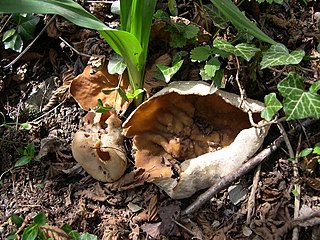
Disciotis is a genus of fungi in the family Morchellaceae. Members of this family, characterized by their cup- or bowl-shaped apothecia, have a widespread distribution, especially in northern temperate regions.

Morchella elata is a species of fungus in the family Morchellaceae. It is one of many related species commonly known as black morels, and until 2012 the name M. elata was broadly applied to black morels throughout the globe. Like most members of the genus, M. elata is a popular edible fungus and is sought by many mushroom hunters.
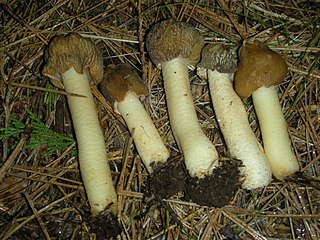
Verpa conica, commonly known as the bell morel or the early morel, is a species of fungus in the family Morchellaceae. Sometimes mistaken for a true morel, this species is characterized by a cap resembling a thimble that is freely attached to the stipe.

Verpa bohemica is a species of fungus in the family Morchellaceae. The synonym Ptychoverpa bohemica is often used by European mycologists and it is commonly known as the early morel or the wrinkled thimble-cap. The mushroom has a pale yellow or brown thimble-shaped cap—2 to 4 cm in diameter by 2 to 5 cm long—that has a surface wrinkled and ribbed with brain-like convolutions. A feature distinguishing the species from true morels, the cap hangs free from the top of the stem, which is lighter in color, brittle, and up to 12 cm long by 1 to 2.5 cm thick. Microscopically, the mushroom is distinguished by its large spores, typically 60–80 by 15–18 µm, and the presence of only two spores per ascus.

Leucangium is a genus of ascomycete fungi. The genus was circumscribed by French mycologist Lucien Quélet in 1883. Although classified in the Helvellaceae in the past, molecular analysis indicates it is closely related to the genus Fischerula and Imaia, and therefore must be placed in the Morchellaceae. The genus includes two species, Leucangium ophthalmosporum Quél. and L. carthusianum Paol., and both of them produce sequestrate ascoma, globose to ellipsoidal ascus, and dark olive-colored to grayish green, smooth, fusiform ascospores.

Morchella americana is a North American species of fungus in the family Morchellaceae.
Morchella capitata is a later synonym of Morchella exuberans. Originally identified as phylogenetic species Mel-9, it was described as new to science in 2012 by Kuo and colleagues. In 2014 however, Richard and colleagues clarified the taxonomic status of this species, retaining the name Morchella exuberans of Clowez (2012) over M. capitata.

Morchella septimelata is a species of fungus in the family Morchellaceae described as new to science in 2012. Occurring in western North America, it has been collected from British Columbia, Montana and Oregon, where it fruits at elevations of 1,000 to 2,000 m in coniferous forests in years following slight to moderate burning.

Morchella populiphila is a species of morel fungus native to northwestern North America. Described as new to science in 2012, its specific epithet refers to its association with black cottonwood. The morel used to be referred to as Morchella semilibera in western North American field guides until molecular analysis established that to be a strictly European species. M. populiphila occurs in California, Nevada and Oregon. Its fruit bodies grow up to 15 cm (6 in) tall with a ridged and pitted conical cap that attaches about halfway down the stipe. The cap ridges are dark brown to black in maturity, while the pits are yellowish to brownish. The fungus is edible, although not as highly valued as other morels.

Kalapuya brunnea is a species of truffle in the monotypic fungal genus Kalapuya. The truffle occurs only in the Pacific Northwest region of the United States, in western Oregon and northern California. Known locally as the Oregon brown truffle, it was formerly thought to be an undescribed species of Leucangium until molecular analysis demonstrated that it was distinct from that genus. The truffle is reddish brown with a rough and warty outer skin, while the interior spore-producing gleba is initially whitish before developing greyish-brown mottling as it matures. Mature truffles have an odor resembling garlicky cheese, similar to mature Camembert. The species has been harvested for culinary purposes in Oregon.

Morchella anatolica is a rare species of ascomycete fungus in the family Morchellaceae. It was described as new to science in 2010 from southwest Anatolia, Turkey, where it grows on moss-covered stream beds in pine forests. An ancient climatic relict, M. anatolica is restricted to the Mediterranean basin and has also been documented in Spain, Cyprus and Greece, where it is sometimes encountered with trees of the Oleaceae family. Together with its sister-species Morchella rufobrunnea, they are the earliest diverging lineages in genus Morchella, forming a distinct clade that is basal in global morel phylogenies. Because of its phylogenetic position, M. anatolica has been crucial in inferring the historical biogeography of the genus, which is estimated to have emerged somewhere in the Mediterranean region in the late Jurassic.
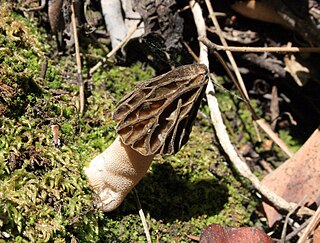
Morchella disparilis is an Ascomycete fungus in the family Morchellaceae. Described as new to science in 2016, M. disparilis appears to be confined to the Mediterranean basin and is so far known from Cyprus, Greece and Spain. Its most striking feature is the exceptionally deep sinus, intermediate in depth between half-free morels of the Morchella semilibera clade and typical Distantes species.
Morchella kakiicolor is a species of fungus in the family Morchellaceae (Ascomycota). It was originally proposed as a form of Morchella quercus-ilicis in a 2012 study by Philippe Clowez, but was later re-combined as an autonomous species by Loizides and colleagues, based on molecular phylogenetic data. In the same study, M. quercus-ilicis f. quercus-ilicis was shown by the authors to be a later synonym of the old taxon Morchella tridentina, and not phylogenetically related to M. kakiicolor.


















